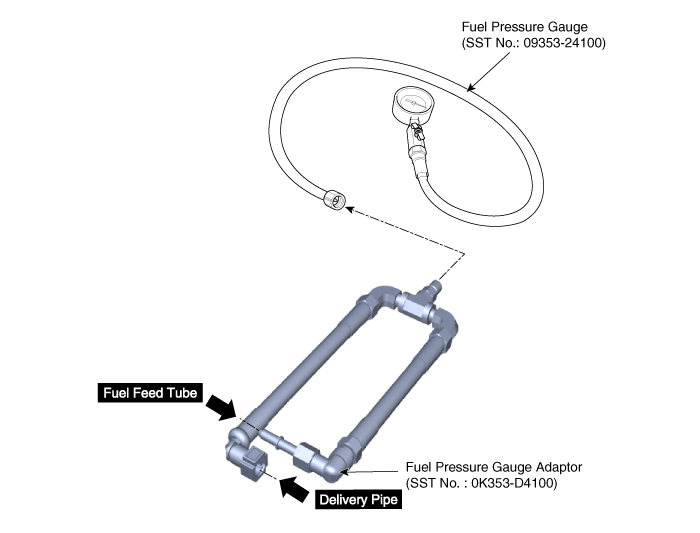Kia Stinger: Engine Control / Fuel System / Fuel Delivery System
Components and components location
| Components Location |
| Fuel Tank & Filler-Neck Assembly |

| 1. Fuel Tank 2. Low Pressure Fuel Pump 3. Sub Fuel Sender 4. Fuel Filler Hose |
5. Leveling Hose 6. Ventilation Hose 7. Filler-Neck Assembly 8. Fuel Pump Plate Cover |
| Low Pressure Fuel Pump |

| 1. Fuel Feed Port 2. Fuel Pressure Sensor (FPS) 3. Fuel Filter 4. Fuel Sender |
5. Fuel Pressure Regulator
6. Head Assembly 7. Reservoir-Cup 8. Pre-filter |
| High Pressure Fuel Line |

| 1. High Pressure Pump 2. High Pressure Pipe 3. Delivery Pipe |
4. Injector 5. Rail Pressure Sensor (RPS) |
Whenever the high pressure fuel pump, fuel pipe, delivery pipe, or injector is removed immediately after shutting off the engine, an injury may be caused by the release of highly pressurized fuel. Release the residual pressure in the high pressure fuel line by referring to the "Residual fuel pressure release procedure" below before removing any high pressure fuel system components. |
Fuel pressure test (low pressure system)
| Fuel Pressure Test (Low pressure system) |
| 1. |
Release the residual pressure in fuel line. (Refer to the Fuel Delivery System - Inspection - "Release Residual Pressure in Fuel Line".)
|
| 2. |
Install the Special Service Tool (SST).
|
| 3. |
Check for fuel leakage from connections on the low fuel feed tube, the low pressure inlet of high pressure fuel pump, and the SST components with ignition "ON". |
| 4. |
Measure the fuel pressure.
|
| 5. |
Release the residual pressure in fuel line. (Refer to the Fuel Delivery System - Repair Procedures - "Release Residual Pressure in Fuel Line").
|
| 6. |
Finish test.
|
Release residual pressure in fuel line
| Release Residual Pressure in Fuel Line |
Whenever the high pressure fuel fuse, fuel pipe, delivery pipe, or injector is removed immediately after shutting off the engine, an injury may be caused by the release of highly pressurized fuel. Release the residual pressure in the high pressure fuel line by referring to the "Residual fuel pressure release procedure" below before removing any high pressure fuel system components. |
Wear safety glasses and fuel resistant gloves. |
| 1. |
Switch "OFF" the ignition and disconnect the negative (-) battery terminal. |
| 2. |
Remove the fuel pump relay (A).
|
| 3. |
Reconnect the negative (-) battery terminal. |
| 4. |
Run the engine for about 1 minute to lower the pressure in the low pressure line. |
| 5. |
Turn the engine off. |
| 6. |
Disconnect the low pressure fuel line quick connector at the High Pressure Pump. Use rags to cover opening and catch spills while removing the fuel line. |
| 7. |
Start the engine and let it idle until the engine stops. At this point the pressure should be under 30 psi. |
| 8. |
Proceed with the service or repair. Use rags to cover opening and catch spills when opening up the high pressure system. |
| 9. |
Reinstall / re-connect all components in reverse order of removal. Start engine and confirm proper operation, and make sure there are no fuel leaks. |
| 10. |
After completing, clear DTC(s) using KDS scan tool. (The procedure described above will cause DTC to set.) |
- Fuel Tank
- Low Pressure Fuel Pump
- Fuel Filter
- Fuel Pump Motor
- Sub Fuel Sender
- Fuel Sender Assembly
- Fuel Pump Control Module (FPCM)
- Fuel Pressure Sensor (FPS)
- Fuel Line
- Filler-Neck Assembly
- Delivery Pipe
- High Pressure Fuel Pump
 Hood switch
Hood switch
Description and operation
Description
Hood switch is one of the factors influencing the activation of the ISG function.
When the hood is open, the engine will not start or stop by the ...
 Fuel Tank
Fuel Tank
Repair procedures
Removal
1.
Release the residual pressure in fuel line.
(Refer to the Fuel Delivery System - "Release Residual Pressure in Fuel
Line")
...
Other information:
Kia Stinger CK 2018-2025 Owners Manual: The Eco-coasting system
When certain conditions are met, the engine is automatically decoupled from the transmission while the shift lever is remained in D (Drive). In this ECO Coasting mode, the engine stays at idling speed to reduce fuel consumption and increase coasting distance. The engine is automatically couple ...
Kia Stinger CK 2018-2025 Service Manual: Heated Steering wheel
Description and operation Description When manually selected, the heated steering wheel system improves the thermal comfort of the driver by heating the steering wheel. 1. Integrated Body Control Unit (IBU) Item Spec ...






